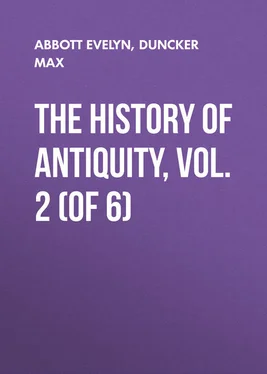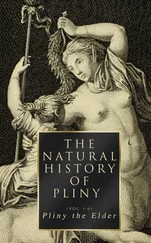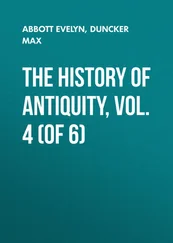Evelyn Abbott - The History of Antiquity, Vol. 2 (of 6)
Здесь есть возможность читать онлайн «Evelyn Abbott - The History of Antiquity, Vol. 2 (of 6)» — ознакомительный отрывок электронной книги совершенно бесплатно, а после прочтения отрывка купить полную версию. В некоторых случаях можно слушать аудио, скачать через торрент в формате fb2 и присутствует краткое содержание. Жанр: foreign_antique, foreign_prose, Историческая проза, на английском языке. Описание произведения, (предисловие) а так же отзывы посетителей доступны на портале библиотеки ЛибКат.
- Название:The History of Antiquity, Vol. 2 (of 6)
- Автор:
- Жанр:
- Год:неизвестен
- ISBN:нет данных
- Рейтинг книги:4 / 5. Голосов: 1
-
Избранное:Добавить в избранное
- Отзывы:
-
Ваша оценка:
- 80
- 1
- 2
- 3
- 4
- 5
The History of Antiquity, Vol. 2 (of 6): краткое содержание, описание и аннотация
Предлагаем к чтению аннотацию, описание, краткое содержание или предисловие (зависит от того, что написал сам автор книги «The History of Antiquity, Vol. 2 (of 6)»). Если вы не нашли необходимую информацию о книге — напишите в комментариях, мы постараемся отыскать её.
The History of Antiquity, Vol. 2 (of 6) — читать онлайн ознакомительный отрывок
Ниже представлен текст книги, разбитый по страницам. Система сохранения места последней прочитанной страницы, позволяет с удобством читать онлайн бесплатно книгу «The History of Antiquity, Vol. 2 (of 6)», без необходимости каждый раз заново искать на чём Вы остановились. Поставьте закладку, и сможете в любой момент перейти на страницу, на которой закончили чтение.
Интервал:
Закладка:
In any case it is clear that a place of the name of Asshur, the site of which is marked by the ruins of Kileh-Shergat, was inhabited about the year 1800 B.C., and that about this time sanctuaries were raised in it. The name of the place was taken from the god specially worshipped there. As Babel (Gate of El) was named after the god El, Asshur was named after the god of that name. The city was Asshur's city, the land Asshur's land. Beside the city of Asshur, about 75 miles up the Tigris, there must have been at the time indicated a second place of the name of Ninua (Nineveh), the site of which is marked by the ruins of Kuyundshik and Nebbi Yunus (opposite Mosul), since, according to the statement of Shalmanesar I., king of Assyria, Samsi-Bin built another temple here to the goddess Istar. 32 32 G. Smith, "Discov." p. 249.
Ismidagon, as well as Samsi-Bin, is called in the inscription of Tiglath Pilesar I. "Patis of Asshur." The meaning of this title is not quite clear; the word is said to mean viceroy. If by this title a vice-royalty over the land of Asshur is meant, we may assume that Assyria was a colony of Babylonia – that it was under the supremacy of the kings of Babylon, and ruled by their viceroys. But since at a later period princes of Assyria called themselves "Patis of Asshur," as well as "kings of Asshur," the title may be explained as meaning that the old princes of Assyria called themselves viceroys of the god of the land, of the god Asshur. Moreover, it would be strange that a colony of Babylonia, which was under the supremacy of that country, should make its protecting god a deity different from that worshipped in Babylonia.
From this evidence we may assume that about the year 1800 B.C. a state named Asshur grew up between the Tigris and the Lesser Zab. This state must have passed beyond the lower stages of civilisation at the time when the princes erected temples to their gods at more than one chief place in their dominions, when they could busy themselves with buildings in honour of the gods after the example of the ancient princes of Erech and Nipur, of Hammurabi, and his successors at Babylon. With this result the statements in the inscriptions of Tuthmosis III do not entirely agree. Two hundred years after the time of Ismidagon and Samsi-Bin they speak only of the chief of Asshur, and of tribute in lapis-lazuli and tree-trunks; but this divergence is not sufficient to make us affirm with certainty that the "Assuru" of Tuthmosis has no reference whatever to Assyria. If we were able to place the earliest formation of a state on the Lower Euphrates about the year 2500 B.C., the beginnings of Assyria, according to the inferences to be drawn from the evidence of the first Tiglath Pilesar and the tiles of Kileh-Shergat, could not be placed later than the year 2000 B.C.
Beside Ismidagon and Samsi-Bin, the inscriptions of Tiglath Pilesar and the tiles of the ruins of Kileh-Shergat mention four or five other names of princes who belong to the early centuries of the Assyrian empire, but for whom we cannot fix any precise place. The date of the two kings, who on Assyrian tablets are the contemporaries of Binsumnasir of Babylon, Assur-nirar, and Nabudan, could not have been fixed with certainty if other inscriptions had not made us acquainted with the princes who ruled over Assyria in succession from 1460 – 1280 B.C. 33 33 The date of Tiglath Adar is fixed by the statement of Sennacherib that he lost his seal to the Babylonians 600 years before Sennacherib took Babylon, i. e. about the year 1300 B.C. As the series of seven kings who reigned before Tiglath Adar is fixed, Assur-bil-nisi, the first of these, can be placed about 1460 B.C. if we allow 20 years to each.
From these we may assume that Assur-nirar and Nabudan must have reigned before this series of princes, i. e. before 1460 B.C., from which it further follows that from about the year 1500 B.C. onwards Assyria was in any case an independent state beside Babylon. We found above that the treaty which Assur-bil-nisi, king of Assyria, concluded about the year 1450 B.C. with Karaindas, king of Babylon, for fixing the boundaries, must have been preceded by hostile movements on the part of both kingdoms. We saw that Assur-bil-nisi's successor, Busur-Assur, concluded a treaty with the same object with Purnapuryas of Babylon, and that Assur-u-ballit, who succeeded Busur-Assur on the throne of Assyria, gave his daughter in marriage to Purnapuryas. In order to avenge the murder of Karachardas, the son of Purnapuryas by this marriage, who succeeded his father on the throne of Babylon, Assur-u-ballit invaded Babylonia and placed Kurigalzu, another son of Purnapuryas, on the throne. We might assume that about this time, i. e. about 1400 B.C., the borders of Assyria and Babylonia touched each other in the neighbourhood of the modern Aker-Kuf, the ancient Dur-Kurigalzu. 34 34 Vol. i. p. 262.
Assur-u-ballit, who restored the temple of Istar at Nineveh which Samsi-Bin had built, was followed by Pudiel, Bel-nirar, and Bin-nirar. 35 35 This series, Pudiel, Bel-nirar and Bin-nirar, is established by tiles of Kileh-Shergat, and the fact that it joins on to Assur-u-ballit, by the tablet of Bin-nirar discovered by G. Smith, in which he calls himself great grandson of Assur-u-ballit, grandson of Bel-nirar, and son of Pudiel; G. Smith, "Discov." p. 244.
The last tells us, on a stone of Kileh-Shergat, that Assur-u-ballit conquered the land of Subari, Bel-nirar the army of Kassi, that Pudiel subjugated all the land as far as the distant border of Guti; he himself overcame the armies of Kassi, Guti, Lulumi and Subari; the road to the temple of the god Asshur, his lord, which had fallen down, he restored with earth and tiles, and set up his tablet with his name, "on the twentieth day of the month Muhurili, in the year of Salmanurris." 36 36 G. Smith, "Discov." pp. 244, 245.
Bin-nirar's son and successor was Shalmanesar I., who ascended the throne of Assyria about 1340 B.C. We learnt above from Genesis, that "Asshur built the cities of Nineveh, Rehoboth-Ir, Resen and Chalah." Assur-nasirpal, who ruled over Assyria more than 400 years after Shalmanesar I., tells us that "Shalmanesar the mighty, who lived before him, founded the ancient city of Chalah." 37 37 E. Schrader, "Keilinschriften und A. T." s. 20; "Records of the Past," 7, 17.
It is thus clear that Assyria before the year 1300 B.C. obtained a third residence in addition to the cities of Asshur and Nineveh. Like Asshur and Nineveh, it lay on the banks of the Tigris, about 50 miles to the north of Asshur, and 25 to the south of Nineveh. It was not, however, like Asshur, situated on the western bank of the river, but on the eastern, like Nineveh, a little above the junction of the Upper Zab, in a position protected by both rivers, and thus far more secure than Asshur. Shalmanesar also built in both the old residences of Asshur and Nineveh. Tiles of Kileh-Shergat bear the stamp, "Palace of Shalmanesar, son of king Bin-nirar." 38 38 Ménant, "Annal." p. 73.
His buildings in Nineveh are certified by an inscription, in which Shalmanesar says: "The temple of Istar, which Samsi-Bin, the prince who was before me, built, and which my predecessor Assur-u-ballit restored, had fallen into decay in the course of time. I built it up again from the ground to the roof. The prince who comes after me and sees my cylinder (p. 37), and sets it again in its place, as I have set the cylinder of Assur-u-ballit in its place, him may Istar bless; but him who destroys my monument may Istar curse and root his name and race out of the land." 39 39 G. Smith, loc. cit. p. 249.
In the same inscription Shalmanesar calls himself conqueror of Niri, Lulumi and Musri, districts for which – at any rate for the two last – we shall have to look in the neighbourhood of Nineveh, in the chain of the Zagrus. The son of Shalmanesar I. was Tiglath Adar; he completed the restoration of the temple of Istar at Nineveh, and fought with such success against Nazimurdas of Babylon that he placed on his seal this inscription: "Tiglath Adar, king of the nations, son of Shalmanesar, king of Asshur, has conquered the land of Kardunias." But he afterwards lost this very seal to the Babylonians, who placed it as a trophy in the treasure-house of Babylon (about 1300 B.C.). 40 40 G. Smith, loc. cit. p. 250; E. Schrader, "A. B. Keilinschriften," s. 294. As Sennacherib states that he brought back this seal from Babylon after 600 years, and as Sennacherib took Babylon twice in 704 and 694 B.C., the loss of it falls either in the year 1304 or 1294 B.C. As he brings back the Assyrian images of the gods at the second capture (694 B.C.), the seal of Tiglath Adar may have been brought back on this occasion.
Интервал:
Закладка:
Похожие книги на «The History of Antiquity, Vol. 2 (of 6)»
Представляем Вашему вниманию похожие книги на «The History of Antiquity, Vol. 2 (of 6)» списком для выбора. Мы отобрали схожую по названию и смыслу литературу в надежде предоставить читателям больше вариантов отыскать новые, интересные, ещё непрочитанные произведения.
Обсуждение, отзывы о книге «The History of Antiquity, Vol. 2 (of 6)» и просто собственные мнения читателей. Оставьте ваши комментарии, напишите, что Вы думаете о произведении, его смысле или главных героях. Укажите что конкретно понравилось, а что нет, и почему Вы так считаете.












